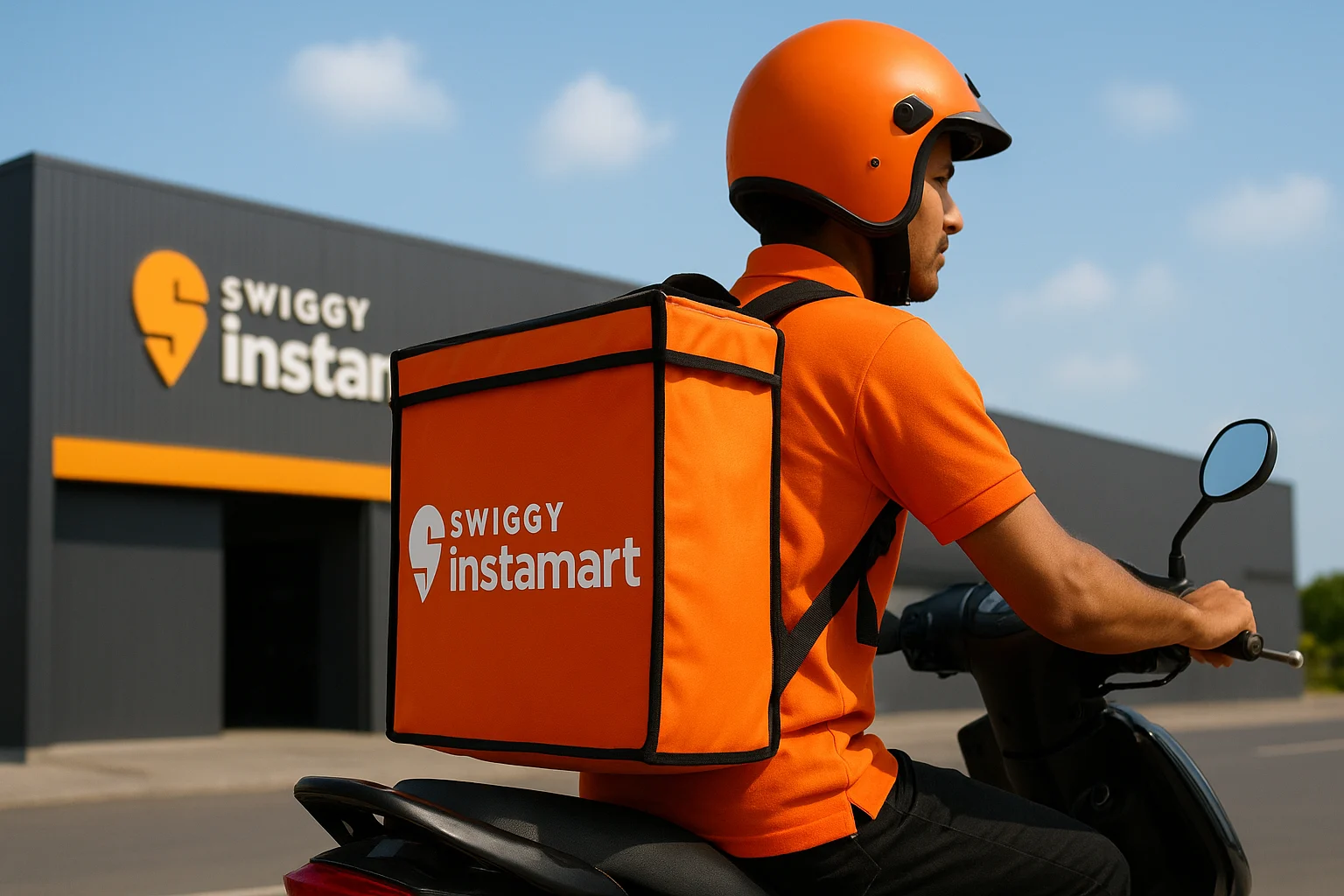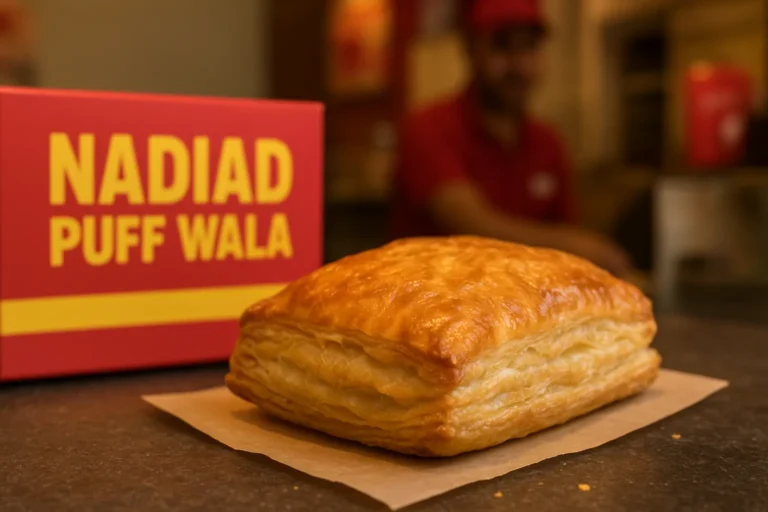1. The Current Landscape — Why Instamart Matters
- Swiggy Instamart, the quick-commerce arm of Swiggy, is increasingly a growth lever in a business that has faced margin pressure in the traditional food-delivery segment.
- For Q2 FY26, analysts estimate Swiggy’s consolidated revenue could rise ~51 % YoY to ~₹5,448.8 crore, largely driven by Instamart, even while losses remain elevated.
- In Q4 of FY25, Instamart achieved a 101 % YoY growth in Gross Order Value (GoV) reaching ~₹4,670 crore, added 316 dark stores in one quarter, and expanded to 124 cities.
- At the same time, the wider “10-minute delivery” quick-commerce model is transforming urban retail in India — leveraging small fulfilment centres (dark stores), high-frequency orders, and rapid delivery.
Takeaway: Instamart is no longer a side-project. It’s a strategic play, occupying the “quick commerce” lane in India’s retail economy — and for franchising discussions, this is a huge potential lever to watch.
2. Key Strategic Moves & Innovations
Here are some recent developments that highlight how Instamart is evolving:
- Gold & Silver Delivery on Dhanteras (Oct 2025)
Instamart tied up with jewellery brands (e.g., Kalyan Jewellers, Malabar Gold) to deliver 1 g gold coins and up to 1 kg silver bricks in 10-15 minutes in key metros (Ahmedabad, Bengaluru, Delhi NCR, Hyderabad, Mumbai).
This move signals two things: pushing quick commerce beyond groceries, and raising the perceived value of the channel. - Premium Product Tie-ups — e.g., Laptops
Instamart’s tie-up with ASUS India enables rapid delivery of consumer and gaming laptops (starting ~₹33,990) in major cities.
The channel is positioning itself as a “more than groceries” proposition. - Organic Staples Push
Through a partnership with Bharat Organics (farmer-led cooperative) and National Cooperative Organic Limited (NCOL), Instamart is adding certified organic staple products in major cities.
This reflects a strategy to tap higher margin / higher involvement categories. - Competitive Pressure & Market Dynamics
The competitive intensity in quick commerce is rising. For example, JioMart (via Reliance Retail) has entered the 10-minute delivery race, leveraging ~3,000 stores + 600 dark stores — representing a direct competitive threat to Instamart’s metro-moat.
3. Franchise / Business-Model Implications
From a franchising or partnership-perspective, here’s what each of these developments mean — especially useful if you’re writing a blog for franchise interests:
- Dark Store Model & Real Estate: The rapid growth in dark stores (316 added in one quarter) indicates a high fixed-cost, asset-intensive strategy. For potential franchisees or local partners, this suggests the importance of location, logistics and deliverability.
- New Category Expansion = Upside for Franchisees: With gold/silver delivery and consumer electronics, Instamart is broadening the “quick commerce” value proposition. Franchisees benefit from higher-AOV (average order value) categories.
- Customer Acquisition Focus: Given the margin pressure, the model currently heavily leans on growth (GoV, new cities) rather than profits. Being in one of the expansion cities or underserved markets may present early-entry advantages.
- Competitive Risks: As giants like Reliance enter the same space, franchisees must assess: Can your local zone maintain competitive delivery speed, stock depth, and customer satisfaction?
- Operational Excellence Matters: Speed (10-minute expectation), dark-store routing, fulfilment technology, micro-logistics all must work seamlessly. Franchise partners need to gauge whether the overheads/logistics make sense in their region.
4. Comparative Snapshot: Instamart vs. Rivals
| Player | Model & Strength | Challenges | What this means for franchise/blog context |
| Instamart | Leveraging Swiggy’s app ecosystem + quick commerce expansion. Strong metro presence. | Margin losses, rising competition. | Franchisees should look at metro/large-city roll-out phases. |
| Zepto / Blinkit | Pure “quick commerce” plays with aggressive expansion. | Sustainability of losses, reliance on heavy discounting. | Mirrors what Instamart faces — local partner must account for discounting pressure. |
| JioMart / Reliance Retail | Massive store network + omnichannel + dark stores. Bigger physical asset base. | Legacy systems, scaling ultra-fast delivery. | For franchisees: Incumbent pressure means differentiation is key. |
5. What’s Next — Trends to Watch for a Franchise Blog Angle
For content that is Discover-friendly (i.e., Google Discover), case-study/deep-dive style, here are key angles and upcoming triggers:
- Expansion into Tier II/III Cities: Much of the early focus has been metros. The “next wave” is smaller cities: How will Instamart adapt for lower density, longer delivery times, different consumer behaviour?
- Category Diversification: With gold, electronics and organic staples, how far can the “quick” model go? Will Instamart become a mini-mall rather than just groceries?
- Profitability Inflection: With Q2 numbers point to revenue growth but still heavy losses, watch for when take-rate, contribution margins, logistics cost per order improve. Blog angle: “When does growth turn into profit for franchise partners?”
- Technology & Fulfilment Innovation: Dark stores, micro-fulfilment, AI routing — franchise blog can highlight how local franchise partners must align with the technical backbone.
- Regulatory / Ecosystem Risks: As quick commerce expands, regulatory scrutiny (e.g., distributor complaints) may rise. Be prepared for stories about margin squeeze, disruption of local retail, regulation.
- 6. Suggested Blog Outline for Your Franchise Website
Here’s a structured outline you can plug into for your blog:
- Introduction
- Brief snapshot of Instamart’s position in India’s quick-commerce revolution.
- Why it matters for potential franchise partners.
- The Growth Story So Far
- Highlight latest stats: GoV growth, store expansion, new categories.
- Use quotes/data from recent reports (e.g., 101 % YoY growth, dark store additions).
- Business Model & Franchise Relevance
- Explain the dark-store + quick-delivery model.
- Break down what a franchisee/local partner may need (location, logistics, tech stack, delivery network).
- Discuss operating costs, revenue streams, key metrics (AOV, take-rate, frequency).
- Category Innovation & Differentiation
- Cases: gold/silver delivery on Dhanteras (premium offering) + electronics tie-ups + organic staples.
- Why expanding categories matter (higher AOV, new customer segments).
- Implications for franchisees: cross-selling, local inventory, partnerships.
- Competitive Landscape & Risks
- Map the rivals: Zepto, Blinkit, JioMart.
- Key threats: margin pressure, competition in delivery speed, logistics cost, urban saturation.
- Opportunities: Underserved cities, niche categories, premium segments.
- What Franchise Partners Should Look For
- Location & delivery radius metrics.
- Inventory/assortment management.
- Technology readiness and integration with the larger platform.
- Financial model: setup cost, breakeven timeline, expected AOV, order frequency.
- Scalability and local adaptation (Tier II/III vs metro).
- Trend-Watch: What’s Coming Next
- Role of AI/logistics in improving margins.
- Expansion into non-grocery categories.
- Consumer behaviour shift: instant vs scheduled delivery; premium products; sustainable/organic goods.
- Regulatory and ecosystem changes (urban logistics, labour rules).
- Conclusion
- Summarise why Instamart is a compelling franchise decision now, but also caution what needs to be evaluated.
- Call–to-action for franchisees: what to do next — research local demand, talk to the platform, crunch the numbers.





